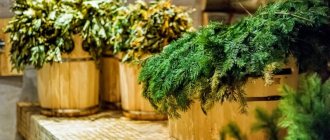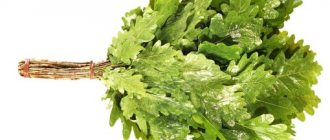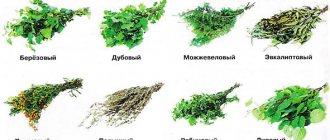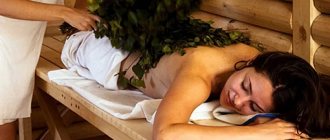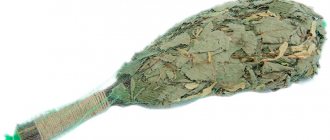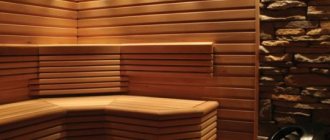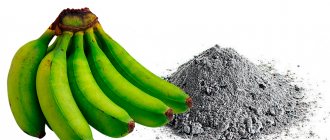To enhance the healing effect of visiting the steam room, many use medicinal herbs for the bath: by collecting and drying the plants with our own hands, we obtain a material that is unique in its properties.
Even if you focus on those species that grow only in our area, you can put together a good green first aid kit. Well, there are many ways to use these herbs, and we will talk about the most popular ones in the article below.
You can actively use natural medicines in the steam room
What are the benefits of herbs for a bath?
A visit to the bathhouse is not only hygienic procedures, but also health technologies, physical and psychological. In the hot air of a steam room, plants release healing aromas, affecting well-being, mood, tuning into the right mood, calming and relaxing.
The effect of herbal aromatic oils occurs simultaneously in several directions:
Inhaling the molecules has a beneficial effect on the respiratory system. Essential particles settle on the mucous membranes, are absorbed through capillaries and enter the blood. Circulating through the vessels, medicinal substances reach almost all organs and heal tissues.
The impact on the olfactory receptors in the nasal cavity causes a reaction from the nervous and hormonal systems. Aromatherapy promotes relaxation and restoration of psycho-emotional background. As a result, a person is freed from irritation and anxiety.
Staying in a steam room helps open skin pores. Due to this, the process of removing toxins is accelerated. At the same time, the ability of the epidermis to absorb molecules of essential oils increases. They enter the lymphatic system and begin to circulate through it.
Dry mustard
Steam using dry mustard is considered antibacterial and even anthelmintic - it destroys parasites. It also increases libido and sharpens vision.
Mustard steam is effective for preventing colds. To do this, dilute a tablespoon of dry mustard powder in five liters of warm water (no more than 60°C).
If the priority is aromatic rather than healthy properties, the seasoning is slightly fried in advance or burnt sugar is added. You will get rich steam that will have a positive effect on your well-being.
What herbs and how they affect the body
The nature of the effect on the body depends on the type of herb used in the bath. You need to select them based on the state of your own body and the desired effect of the procedure.
Melissa
This herb has a sweetish smell.
Even the working bees appreciated Melissa. This feature of its nectar was noticed by the ancient Greeks. They compared the aroma of this herb with divine nectar, and the physician Paracelsus called it “the elixir of life.” Translated from Greek, “Melissa” means “honey bee”. Melissa is a proven and generally accepted remedy in the fight against physical fatigue, tension and pain in muscles, joints, and back. Helps relieve itching after insect bites, relaxes, soothes, and normalizes sleep.
St. John's wort
The plant has rightly earned the title of “folk healer”. Its tissues contain hypericin, a substance that has a calming effect on the nervous system and improves the health of the respiratory system.
St. John's wort strengthens the heart muscle, relieves headaches and muscle pain, and treats skin diseases. The plant contains a large amount of phytoncides that have antiviral and antimicrobial effects.
Nettle
The tissues of this weed contain vitamins, tannins, formic acid, and mineral salts. Nettle steams, entering the respiratory system, help improve well-being, fill the organs with energy, and serve as a prevention of colds.
Regular use of nettle infusion as a tea can relieve chronic fatigue, relieve nervous tension, and stabilize blood pressure. Nettle has an effective effect on the skin. It becomes elastic and elastic. Abscesses, wounds and irritations heal quickly.
Mint
For bath procedures, 2 types of mint are used: peppermint and field mint. The plant contains menthol, so the steam it produces stimulates brain activity, facilitates breathing, and has an antiseptic effect on the skin.
The aroma of mint treats colds, relieves cramps, helps cope with nausea and general malaise.
Chamomile
The ubiquitous field plant is famous for its anti-inflammatory, antiseptic, soothing, and wound-healing effects.
The aroma of chamomile calms, relaxes, relieves anxiety and stress.
Oregano
The spicy and tart aroma of oregano is due to the essential oils it contains. They saturate steam, which in turn has a powerful healing effect on the body.
Oregano is useful for bronchitis, diathesis, and liver diseases. Its aroma returns spiritual harmony and tranquility to a person.
Spiraea
The plant has a honey aroma and is most often combined with oak bath brooms. The infusion is used to make lotions for joint pain. Meadowsweet effectively fights tumors, ulcers and burns, and helps accelerate wound healing.
Meadowsweet decoctions are the best remedy against headaches and skin problems. They also have a thinning property, which makes them indispensable for increased blood clotting. The plant is known for its anti-diabetic, sedative and anti-cold effects.
Ledum
The key benefit of this plant is the presence of essential oils, thanks to which it has a disinfectant and anti-inflammatory effect.
Massage with a broom with wild rosemary calms the nervous system, dilates pores, promotes muscle relaxation and lowers blood pressure.
Carefully! Essential oils of wild rosemary in high concentrations can cause dizziness and nausea.
Yarrow
This herb is the best remedy for stimulating metabolism and treating skin inflammation. Yarrow helps get rid of hair problems, restoring it to a healthy appearance due to its saturation with useful components.
The plant is used for stomach diseases, inflammation of the bladder and kidneys, and diathesis. The essential oils it contains accelerate the healing of small wounds and cracks on the skin.
Sagebrush
The composition of the tissues of this plant includes amino acids, minerals, potassium salts, vitamins A, B, C. Essential oils help reduce headaches, stimulate memory and increase performance. Wormwood has a positive effect on the nervous system, helps to relax, relieve emotional stress and forget about stress.
If you have had a busy week at work, have a persistent headache, and find it difficult to concentrate, make a decoction of wormwood. It will help you relax and put your thoughts in order.
Sage
Infusions and decoctions of sage are classified as disinfectants because this plant kills bacteria. Steam with the aroma of this plant will help in the fight against lung diseases: it effectively destroys viruses in the upper respiratory tract.
Sage contains substances that can normalize the functioning of the sebaceous glands. Thanks to them, the skin becomes less oily.
Sweet clover
An infusion of sweet clover will provide a wonderful aroma in the steam room. The plant promotes relaxation, helps in the fight against stress and neuroses.
If you apply a warm bag of this herb to your joints, it will help relieve pain and swelling.
Tansy
The plant has antipyretic, regenerating, soothing properties. Tansy is used as a diaphoretic and anti-fever remedy, as well as to treat colds, joint aches, headaches and chronic migraines.
Dry stems with inflorescences are excellent raw materials for a bath broom. They tone, invigorate, remove toxins and improve skin condition. The stems of the plant are long and dense, they do not get wet, remain elastic and massage the heated body well.
Important! Due to the high content of essential oils, the aroma of tansy may be too strong. Therefore, professional bath attendants recommend including plant branches in prefabricated brooms: birch or oak.
Zubrowka
This perennial plant from the cereal family contains a lot of minerals and vitamins. Has antiseptic properties. It is a hemostatic agent.
Normalizes the functioning of the nervous system and stabilizes the heart rate. Bison decoction gives a pleasant aroma of freshly cut hay, relaxes and at the same time tones.
Eucalyptus tincture
The eucalyptus aroma in the bath restores the emotional state and improves tone. Entering the body through the respiratory tract and enlarged pores, the herbal aroma improves the functioning of all systems and organs, the condition of the heart and blood vessels.
Also, the smell of eucalyptus is effective for diseases of the upper respiratory tract. This steam is better than any inhalation: add five to six drops of eucalyptus oil to two liters of water. Or pour one tablespoon of plant leaves into a glass of boiling water and leave for 20 minutes. The infusion is filtered and diluted in two liters of water.
How to prepare herbs for a bath
Most plants are harvested during the flowering period, preferably in the morning, in dry weather. Herbs should be dried in a well-ventilated area, preferably hanging. You can lay out plants on paper or fabric, but on the condition that they are regularly turned over and the lining is changed.
To store dried herbs you will need linen bags. The ideal option is bags made of burlap or canvas; they will allow water to pass through well.
But you can sew them from chintz, cotton fabric or old waffle towels.
For each bag you need to prepare a string and a tag so that you don’t have to determine what is inside later. The grass is crushed a little and poured into a container. You can mix several types of herbs in one bag.
Important! The bags should be well stretched and ironed on both sides. This will prevent the herbs from being spoiled by mold fungi and other microorganisms.
Ways to use herbs
In the steam room, medicinal herbs are used in three ways: in the form of infusions (decoctions) for steaming, as a component of a bath broom, and by hanging bunches of herbs in the steam room.
You can hang bunches of dried herbs in the bathhouse. Today, herbal baths are also presented in the form of powders. They are stored in bags and used while relaxing in the bathhouse to create a special atmosphere in the steam room. It is important that the bags are made of natural materials: chintz, linen, calico.
Expert opinion
Lovkachev Boris Petrovich
Bath master who knows everything about steaming
Be sure to familiarize yourself with the effects of herbs, indications and contraindications before using them in a bath. You need to be careful when using plants if you are prone to allergic reactions.
What is called “parking”?
Since ancient times, our ancestors have used medicinal herbs and their preparations for health. By steaming them, they inhaled it and, along with bathing, received a healing effect. It was not for nothing that all illnesses were driven out with the help of a Russian bathhouse with a broom and steamers.
Throughout the warmer months, knowledgeable people collected all kinds of herbs, arranged them in bouquets, dried them, and then used them as medicine or infusion.
Currently, those who like to steam in a sauna or steam bath do not have time to look for places, collect the necessary herbs, and then process and dry them. Therefore, you should go to any store that sells bath accessories and purchase special steamers there. They take the form of small fabric bags (always made of natural linen) filled with crushed herbs or a mixture of them, as well as packaged disposable bags (similar to tea bags).
How to prepare a decoction
To prepare a decoction, you can use one or several types of herbs. A proper combination can enhance the effect of each.
Procedure for preparing the decoction:
- The herbs are dried and at the right time poured into an enamel bowl.
- Boil water in a separate bowl - 3 - 4 liters per 100 g of herb.
- Pour boiling water over the herbs and put on fire.
- Bring to a boil and reduce heat.
- Cover the pan with a lid and keep on low heat for 5-7 minutes.
- Let the broth brew.
Bath infusions are prepared from fresh herbs. The crushed leaves are poured with boiling water and allowed to brew for 40 minutes. For 100 gr. plants will need 1-1.5 liters of water.
Using infusions and decoctions in the steam room
Delicious steam in a sauna can be obtained in two ways:
Dipping a bath broom into a herbal decoction. This method is especially useful if treatment of skin problems is needed. The steamed broom is immersed in a filled basin and the broth is sprinkled throughout the steam room.
Herbal decoction on the stove. To obtain healing steam, the stones are first doused with boiling water. The surface cools sharply, and at this moment a portion of the broth is splashed onto the stones. Then clean water is supplied 2-3 times and the procedure is repeated with the decoction. With this approach, the herbs give all their benefits.
Before serving a portion of the broth on the heater, place fresh spruce spruce branches on the shelves. Century will give a powerful aroma and, in combination with herbal steam, will create the effect of walking through a coniferous forest.
Important! If during a visit to the steam room you experience unpleasant sensations or your health worsens, you should ventilate the room and do not use this herbal composition.
Steaming and use process
To get the maximum effect from steaming, you need to prepare and apply it correctly. According to the recommendations of experts, the sequence of the process is as follows:
- Pour 5 liters of hot, but not boiling water into the steaming container (this can be a special steamer or tub).
- Place a bag or sachet with steaming mixture in it for 15-20 minutes.
- After this, carefully remove the herb or collection with a ladle and leave it indoors for a while. The remaining phytoncides will fill it with aroma and nutrients.
- Pour a ladle of clean hot water over the heater.
- When the steam dissipates, after 15-20 seconds, splash a small amount of herbal infusion. If necessary, the procedure can be repeated.
If anyone present in the bath has contraindications or is individually intolerant to the components of the steaming, it is better not to use it in order to avoid complications.
Herbal recipes
Herbs are most effective if they are used not individually, but as part of medicinal mixtures. You can come up with combinations yourself, depending on the characteristics of the body and the goals pursued.
But there are several fees tested by bathhouse attendants:
- Bactericidal. It contains mint, thyme, eucalyptus and sage in equal proportions. Use the decoction when you first enter the steam room, since the resulting steam does an excellent job of disinfecting the skin. The essential oils contained in the air from this decoction have a positive effect on the respiratory system.
- Relaxing . Mint, chamomile, thyme, and spruce needles are used. The use of steaming will be especially useful for smokers and those who are trying to break a bad habit. The calming effect of steam makes it easier to cope with the syndrome class=”aligncenter” width=”1000″ height=”279″[/img]
- Tonic. To prepare the decoction, tansy, bison, and poplar buds are used. The use of such steam is recommended for those who feel weak when visiting a steam room. To enhance the tonic effect, you can add lavender or jasmine to the composition.
FAQ
What is better, buy herbs or prepare it yourself?
Currently, specialized online stores and even supermarkets offer a really wide range of different types and combinations of herbs for steaming. The average price for a 50-gram package varies in the range of 100 – 150 rubles. The effect of self-collected and ready-made fees is the same.
Is it possible to use herbs if there is a child in the bath?
If the child is not prone to allergies, various herbs can be used. Leaves of eucalyptus, thyme, sage and mint are used to disinfect the air. To improve breathing, take dry leaves of thyme, oregano, birch, oak and linden. Fresh pine needles, birch buds, chamomile, oregano, mint, and thyme will have a calming effect on the child.
By using herbs and infusions wisely, you can increase the healing effect of bath procedures, improve your well-being and solve many health problems. The main thing is to use plant raw materials thoughtfully, taking into account the characteristics of its effects and possible contraindications.
Top 3 best expensive options
Bath things: mint, eucalyptus, juniper 32161
The set contains three varieties of herbs. Mint has calming properties, as it relieves fatigue and tones every cell of the body. Thanks to eucalyptus, no virus or bacteria will ruin your weekend. And to increase brain performance, juniper is used. The products are used separately or combined.
The average cost is 310 rubles.
Bathroom stuff: mint, eucalyptus, juniper 32161
Advantages:
- Three types of plants;
- Anti-inflammatory effect;
- Cheerfulness;
- Improved mood;
- Convenient to use.
Flaws:
- Not found.
Large batch of 12 herbs
This option is used when creating a decoction in a deep vat. Since the weight of the bag is 300 grams. Here you can find useful and popular plants that stabilize the functioning of organs and also improve your mood. Package size – 23x13 cm.
Sold at a price: from 450 rubles.
Big parka 12 herbs
Advantages:
- A simple way to prepare an infusion;
- 12 useful herbs;
- Unique smell;
- Boosting immunity.
Flaws:
- Not found.
Dobroparov Thyme in a tin
A fragrant product that differs from previous versions as it is sold in a tin. Capacity – 850 ml. To use, a person will need to purchase filter bags; they are sold in various stores.
The average price is 450 rubles.
Dobroparov thyme in a tin can
Advantages:
- Package;
- Smell;
- Produced in Russia;
- Shelf life - 3 years.
Flaws:
- Requires filter bags.
